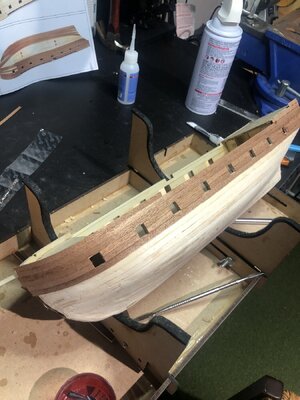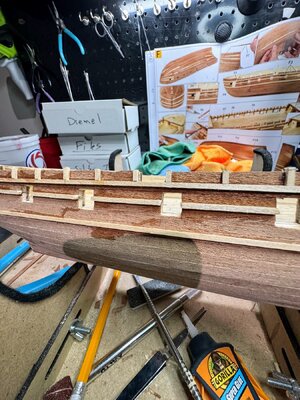Working on my first model, build log here, and I am getting better but I still struggle with over gluing and I have areas of where the CA glus has turned white....is there a way to clean those areas? How can I clean without breaking down the integrity of the glue? Any advice?
-
LUCZORAMA SHIPWRECK SCAVENGER HUNT GIVEAWAY. 4 Weeks of Fun • 1 Legendary Prize ((OcCre’s Fram Ship)) • Global Crew Welcome!
**VIEW THREAD HERE**
You are using an out of date browser. It may not display this or other websites correctly.
You should upgrade or use an alternative browser.
You should upgrade or use an alternative browser.
Kurt Konrath
Kurt Konrath
Might try using a q-tip swap with a light coat of acetone or fingernail polish remover to remove excess CA.
Kurt Konrath
Kurt Konrath
Another tip I have seen to help prevent this issue is to cover nearby area with blue tape, excess drips on tape and you can remove ASAP to keep it from sticking down or having glue spread out where not wanted.
Thank you for the tip....i will try this.Might try using a q-tip swap with a light coat of acetone or fingernail polish remover to remove excess CA.
visible CA-glue I am scratching away with a sharp chisel.
But in principle I try to avoid using CA - I am using for most connections waterbased wood glue.
You are saying, that sometimes you have to much glue there, so I interprete this, that you use directly the bottles - with this you are not able to dimension the volume of glue in a accurate way.


some modelers are using syringes -
I f.e. put a bigger drop of glue (CA or wood-glue) on a piece of paper and take over a small volume of glue on the tip of a toothpick
But in principle I try to avoid using CA - I am using for most connections waterbased wood glue.
You are saying, that sometimes you have to much glue there, so I interprete this, that you use directly the bottles - with this you are not able to dimension the volume of glue in a accurate way.


some modelers are using syringes -
I f.e. put a bigger drop of glue (CA or wood-glue) on a piece of paper and take over a small volume of glue on the tip of a toothpick
take also a look here in this other actual topic
What doesn't super glue stick to??
I think over the years I've glued my project to the mat more than to themselves. I read that Super glue won't stick to silicone. I'm thinking of buying a silicone mat to glue small pieces on. My self-healing mats are scarred and bumpy from super glue incidents, I try to be sparing and careful...
shipsofscale.com
When using superglue I will pour out a little from the bottle into a very small container, then use micro brushes for application. Microbrushes are used by dentists for applying etchant and bonding agents and can be obtained cheaply from this link for instance.
I also prefer to us wood glue over CA & in my case that would be Titebond II. With wood glue you get ample working time to set & adjust the pieces in place. It's also very easy to clean up any excess with a damp cloth. It's meant for wood on wood contact & has superior holding strength.
A couple of ideas for future, One is you can use the add-on micro-tips available. I purchased a bag of 200 of them from Amazon and they work great. That will give you much more control over the amount of glue. The other option to try would be to use a thicker CA glue. That will also give you more control over the amount you are applying. Below is a link to the tips I purchased.
Glue Tips
Glue Tips
Thanks...never thought of a syringe......might try one.visible CA-glue I am scratching away with a sharp chisel.
But in principle I try to avoid using CA - I am using for most connections waterbased wood glue.
You are saying, that sometimes you have to much glue there, so I interprete this, that you use directly the bottles - with this you are not able to dimension the volume of glue in a accurate way.
View attachment 413743 View attachment 413744
some modelers are using syringes -
I f.e. put a bigger drop of glue (CA or wood-glue) on a piece of paper and take over a small volume of glue on the tip of a toothpick
I also did not realize that glue comes in different thicknesses...so I have moved from thin to medium which has helped
Love this idea....this may be for me. This would make getting in those tight spots so much easier....thank you.When using superglue I will pour out a little from the bottle into a very small container, then use micro brushes for application. Microbrushes are used by dentists for applying etchant and bonding agents and can be obtained cheaply from this link for instance.
Are you using any type accelerator? That will turn ca glue white.Working on my first model, build log here, and I am getting better but I still struggle with over gluing and I have areas of where the CA glus has turned white....is there a way to clean those areas? How can I clean without breaking down the integrity of the glue? Any advice?
If you are looking for precise application, consider the Glue Looper. There are different types for different glue viscosities. It fits in an Xacto handle and one pack will last a lifetime.
Here’s a link to the manufacturer’s product videos:
Here’s a link to the manufacturer’s product videos:
Looks like a great way to pin point the glue. I do use CA glue but only in small areas where needed such as a hull plank that did not completely bond. Thanks for sharing.If you are looking for precise application, consider the Glue Looper. There are different types for different glue viscosities. It fits in an Xacto handle and one pack will last a lifetime.
Here’s a link to the manufacturer’s product videos:
Ah…the CA conundrum! The rule is with CA less is better. It does not take a lot of CA to stick parts together so your first lesson is to try to use as little as possible to create the bond. Seriously…very little CA is necessary to do the job! If you are bonding wood parts together there are a few tricks we have learned along the way. One, moisture bonds CA…so litely moisten the parts then less CA is needed to bond…the moisture sets the CA quickly. Second is to understand the various viscosities of CA that tend to work better in the different applications. There is thin, medium, thick, and gel. An example of viscosity application is wood on wood binding…thin CA which most modelers start out with, does indeed wick fast into the fibers of the wood part and therefore does not bond the parts together. So use CA thick or gel…the gel CA does not wick into the wood allowing for proper bonding. I use CA gel a lot especially for planking the hull. My go to glues for my modeling are a variety of CAs with CA gel being my favorite and a PVA white hobby glue that is specifically “fast tack quick dry“ such as Aleene’s Tacky Glue which is a fast tack quick dry hobby glue. I find the PVA glues that are specifically “fast tack quick dry“ better for my modeling than typical wood glues. So just sharing my experiences if they help…
Great info, I like your thought process on using various thicknesses......I'm learningAh…the CA conundrum! The rule is with CA less is better. It does not take a lot of CA to stick parts together so your first lesson is to try to use as little as possible to create the bond. Seriously…very little CA is necessary to do the job! If you are bonding wood parts together there are a few tricks we have learned along the way. One, moisture bonds CA…so litely moisten the parts then less CA is needed to bond…the moisture sets the CA quickly. Second is to understand the various viscosities of CA that tend to work better in the different applications. There is thin, medium, thick, and gel. An example of viscosity application is wood on wood binding…thin CA which most modelers start out with, does indeed wick fast into the fibers of the wood part and therefore does not bond the parts together. So use CA thick or gel…the gel CA does not wick into the wood allowing for proper bonding. I use CA gel a lot especially for planking the hull. My go to glues for my modeling are a variety of CAs with CA gel being my favorite and a PVA white hobby glue that is specifically “fast tack quick dry“ such as Aleene’s Tacky Glue which is a fast tack quick dry hobby glue. I find the PVA glues that are specifically “fast tack quick dry“ better for my modeling than typical wood glues. So just sharing my experiences if they help…
did you perchance, use an accelerator to hasten the adhesion? Accelerators can cause CA to be white. Clean up will help. Maybe use a de-bonder (many available) or acetone. If need be, completely de-bond, clean all the surfaces and then re-glue.Working on my first model, build log here, and I am getting better but I still struggle with over gluing and I have areas of where the CA glus has turned white....is there a way to clean those areas? How can I clean without breaking down the integrity of the glue? Any advice?








